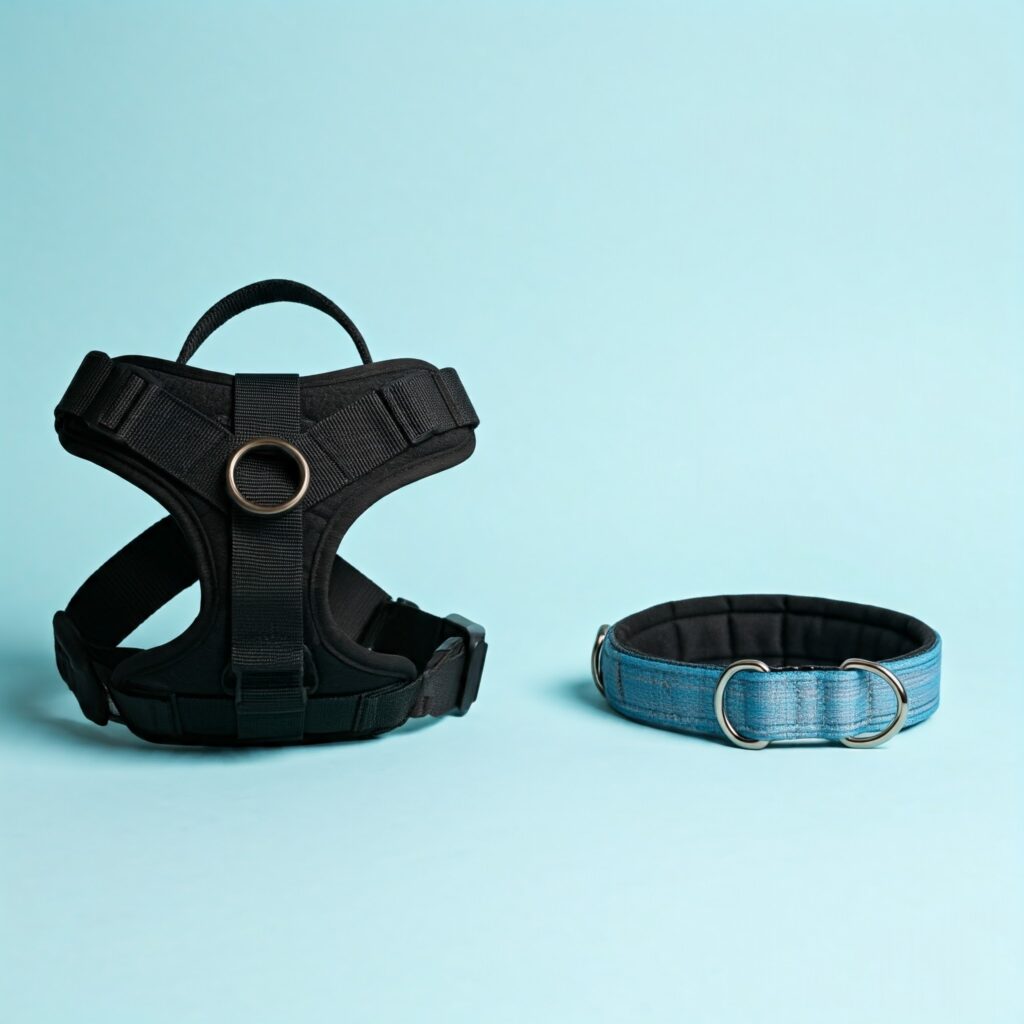When it comes to walking your dog, two of the most common tools you’ll encounter are collars and harnesses. Both serve the purpose of attaching a leash for walks, but each has its distinct advantages and disadvantages, depending on your dog’s size, breed, behavior, and even your training goals. Choosing the right one for your dog isn’t always as straightforward as it seems, and there’s no one-size-fits-all solution. In this blog post, we’ll compare dog harnesses and collars, so you can make an informed decision about which one is best suited to your furry friend.
Understanding Dog Collars

A dog collar is a simple and traditional accessory. It’s typically made of fabric, leather, or other durable materials and fits around your dog’s neck. Collars come in a variety of designs and sizes, and they often feature a buckle, Velcro, or snap mechanism to keep the collar securely on your dog.
Common Types of Dog Collars:
- Flat Collars: These are the most common type of collar, featuring a simple, adjustable strap.
- Martingale Collars: Often used for dogs with narrower heads (like greyhounds), these collars tighten when pulled but don’t choke.
- Choke Chains: These should only be used by experienced handlers as they can cause injury if used improperly.
- Prong Collars: Designed for training, prong collars have metal spikes that gently pinch the dog’s neck to deter pulling. They should also be used with caution.
Pros of Dog Collars:
- Simplicity: Collars are easy to use and often more affordable than harnesses.
- Convenience: You can leave a collar on your dog all the time, which makes it easy to attach ID tags, and it’s less of a hassle to slip on and off.
- Variety: Collars come in a range of styles and materials, so you can find one that fits your dog’s personality and needs.
- Training Benefits: Certain types of collars (like Martingale collars) can help with training, especially for dogs that tend to slip out of traditional collars.
Cons of Dog Collars:
- Risk of Neck Injury: For dogs that pull on the leash, a collar can put unnecessary pressure on their neck, which may lead to tracheal injury, especially in breeds with delicate necks like Chihuahuas or Dachshunds.
- Limited Control: Collars provide less control over your dog’s movements compared to a harness. If you need to correct pulling or other unwanted behaviors, a collar might not provide enough leverage.
- Not Ideal for Dogs with Breathing Issues: Dogs with respiratory issues or brachycephalic (short-nosed) breeds like bulldogs, pugs, and boxers are particularly at risk of injury from collars, as pressure on the throat can exacerbate their breathing problems.
Understanding Dog Harnesses

A dog harness is an alternative to a collar that wraps around your dog’s body, typically across the chest and around the torso. Harnesses are designed to distribute the pressure from a leash evenly across your dog’s body rather than concentrating it on their neck. Harnesses come in a wide range of styles, each with different points of attachment for the leash, and they can be great for controlling strong pullers or dogs with medical concerns.
Common Types of Dog Harnesses:
- Back-Clip Harness: The leash attaches to a ring on the dog’s back, providing minimal interference with the dog’s movement.
- Front-Clip Harness: The leash attaches to the front of the harness, which helps discourage pulling by redirecting the dog’s attention back toward you.
- Dual-Clip Harness: Combines both front and back clip options, giving you versatility depending on your dog’s needs.
- Step-In Harness: A design that your dog steps into, making it easier to put on, especially for squirmy dogs.
- Vest Harness: Typically covers more of the chest and torso, providing added comfort and control, particularly for smaller dogs.
Pros of Dog Harnesses:
- Reduced Risk of Injury: Harnesses distribute pressure more evenly across the dog’s body, reducing the risk of neck injuries, which makes them safer for dogs who pull, or for dogs with existing health concerns like tracheal collapse or respiratory issues.
- Better Control: For dogs that are strong pullers or those that need more guidance, a harness offers better control and leverage. Front-clip harnesses, in particular, make it easier to prevent pulling because they redirect the dog’s movement.
- Comfort: Harnesses are often more comfortable for dogs, especially those with thicker necks or smaller dogs that are prone to respiratory issues. Many harnesses have padding or soft materials that make them gentler on the body.
- Training Aid: A front-clip harness can be a useful training tool for correcting undesirable behaviors like pulling. By attaching the leash to the front of the harness, the dog is gently redirected toward the handler, making it easier to manage their movements.
Cons of Dog Harnesses:
- Complexity: Harnesses can be more difficult to put on compared to a simple collar, particularly for squirmy or excitable dogs. Some harnesses can require more time and effort to adjust for a proper fit.
- Not Ideal for ID Tags: While some harnesses have small loops for ID tags, collars are generally more practical for wearing tags 24/7. If your dog spends time outdoors, a collar might still be necessary for identification purposes.
- Less Visibility in Emergencies: If you need to quickly grab your dog in an emergency, a collar provides a quicker and easier grip around the neck.
When to Choose a Collar
A collar is a great option for:
- Dogs that don’t pull: If your dog is well-behaved on walks and doesn’t pull much, a collar can be the most convenient choice. It’s simple, quick to use, and you can easily attach an ID tag.
- Small dogs: For small breeds that don’t have the strength to pull hard, a collar may be perfectly sufficient. Many small dogs also find collars more comfortable because they don’t need the full-body coverage of a harness.
- Dogs that need to wear ID tags: If your dog is going to be outside off-leash or left alone in the yard, a collar with ID tags is a must-have.
When to Choose a Harness
A harness is a better choice for:
- Dogs that pull: If you have a dog that tends to pull or lunge, a harness can help distribute the force evenly, reducing the strain on their neck and your arm. A front-clip harness is particularly effective at curbing pulling behavior.
- Dogs with respiratory problems: For dogs with sensitive necks, or those suffering from breathing problems (e.g., pugs or bulldogs), a harness is a safer option since it doesn’t put pressure on the windpipe.
- Training purposes: A harness, especially a front-clip version, can be a great training tool to teach your dog proper leash manners. It provides more control over your dog’s movement and helps with redirecting their attention back to you.
Conclusion: Which Is Best for Your Dog?
Ultimately, the decision between a dog harness and a collar depends on your dog’s individual needs and your preferences as an owner. Collars are simple, convenient, and ideal for dogs that don’t pull or for dogs that need to wear ID tags constantly. However, if your dog pulls on the leash, has respiratory issues, or needs extra control during walks, a harness may be the safer and more effective choice.
Some owners even opt to use both: a collar for ID tags and a harness for walks. Understanding your dog’s behavior, physical health, and training needs will help you make the best decision. Regardless of which you choose, both collars and harnesses are important tools for ensuring that your dog’s walks are safe, comfortable, and enjoyable for both you and your canine companion.




